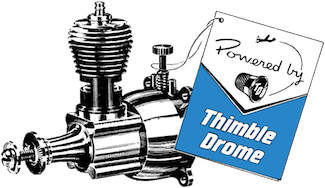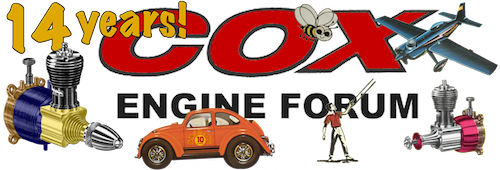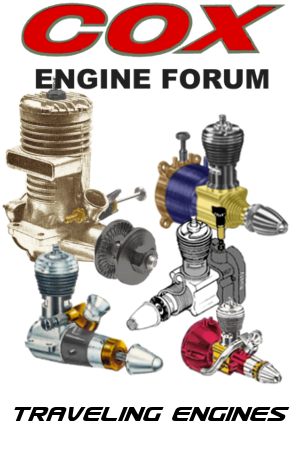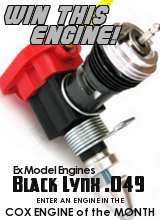Log in
Search
Latest topics
» Stealth SB-Xby Admin Today at 8:28 pm
» ST .35 STUNT / VOODOO / ZERO POINT ZERO NITRO
by TD ABUSER Today at 7:45 pm
» SUPERTIGER .15 PROJECT
by TD ABUSER Today at 7:42 pm
» For sale -- Cox Custom Carburetors for Tee Dee engines
by sosam117 Today at 5:23 pm
» WHERE ARE YOU BUYING YOUR FUEL AND GLOW PLUGS...?
by TD ABUSER Today at 4:35 pm
» Waiting for Engines from Ken Enya
by sosam117 Today at 4:33 pm
» Unusual Cox 049 cylinder - Need help identifying
by anm2 Today at 4:12 pm
» Jim Walker Bonanza etc.
by rsv1cox Today at 2:57 pm
» What's the Best Reed for Cox Reed Valve Engines.
by roddie Today at 1:37 pm
» Fuel choice
by 1975 control line guy Yesterday at 4:01 pm
» "Fall S.M.A.L.L." Video 3.
by GallopingGhostler Yesterday at 2:37 pm
» Gifted Fox
by Ken Cook Yesterday at 11:12 am
Cox Engine of The Month
August-2024
balogh's

"Cox TD09 R/C Beast of Burden featuring Kamtechnik head and DIY metallic fuel nipple"

PAST WINNERS
balogh's

"Cox TD09 R/C Beast of Burden featuring Kamtechnik head and DIY metallic fuel nipple"

PAST WINNERS
Thermal Hopper through firewall
Page 1 of 1
 Thermal Hopper through firewall
Thermal Hopper through firewall
I would appreciate advice on installing a Cox Thermal Hopper .049 engine through the firewall without a cage mount. It is for a Goldberg “Blazer”. I have made a 5/8” diameter hole in the firewall as per the engine instructions, and will have the needle valve and fuel intake spigot horizontal underslung below the fuel-air- mix intake column which runs aft from the engine’s backplate. I have made a 3/8” diameter hole in the fuselage side, close behind the firewall, for the needle valve to exit, and a 3/8” hole on the other side for the fuel line to enter, from an eyedropper tank, or from a similar tubing coil tank. I have removed the nacelle “cheeks” and may taper the fuselage nose to fair into a round firewall which is the same size as the backplate. The firewall will be exactly where the plan shows the engine backplate in its illustrated cage mount installation.The pylon will have to be re-located aft so that the cg will come out right.
The hole in the firewall is sealed by the backplate of course and admits no air. I am wondering how much additional air entry I need to allow beyond the (partially obstructed) 3/8” holes.
It seems advantageous to place a balsa bulkhead some distance behind the firewall, quite close, in order to minimize the area exposed to fuel and for structural reasons (except that it might e wise, for the engine’s sake in a crash, to not make the nose too strong). I am wondering whether the resulting compartment might lead to resonance which would impede air intake and whether one really ought to put the bulkhead 2 to 3 inches back instead of just beyond the venturi. Of course some slipstream exhaust oil and fuel would get into the air holes so that the compartment cannot be expected to stay 100% dry.
Also I wonder whether anyone knows how much fuel might be blown out of the venturi and leak from around the needle valve, with respect to fuel proofing inside, and to cleaning the compartment with a Q-tip, talc, or however.
Might an air intake scoop be preferable to flush holes? Perhaps the Bernoulli effect might create suction above flush holes since the airflow would speed up when going around the fuselage nose?
Especially with regard to the bulkhead placement it would be helpful to hear from practical experience since it would be difficult to re-locate after constructed. Could one usefully make a ½” or ¾” hole in the bulkhead and run from it a large diameter straw back to a beveled exit hole in the fuselage side or bottom some distance aft?
The hole in the firewall is sealed by the backplate of course and admits no air. I am wondering how much additional air entry I need to allow beyond the (partially obstructed) 3/8” holes.
It seems advantageous to place a balsa bulkhead some distance behind the firewall, quite close, in order to minimize the area exposed to fuel and for structural reasons (except that it might e wise, for the engine’s sake in a crash, to not make the nose too strong). I am wondering whether the resulting compartment might lead to resonance which would impede air intake and whether one really ought to put the bulkhead 2 to 3 inches back instead of just beyond the venturi. Of course some slipstream exhaust oil and fuel would get into the air holes so that the compartment cannot be expected to stay 100% dry.
Also I wonder whether anyone knows how much fuel might be blown out of the venturi and leak from around the needle valve, with respect to fuel proofing inside, and to cleaning the compartment with a Q-tip, talc, or however.
Might an air intake scoop be preferable to flush holes? Perhaps the Bernoulli effect might create suction above flush holes since the airflow would speed up when going around the fuselage nose?
Especially with regard to the bulkhead placement it would be helpful to hear from practical experience since it would be difficult to re-locate after constructed. Could one usefully make a ½” or ¾” hole in the bulkhead and run from it a large diameter straw back to a beveled exit hole in the fuselage side or bottom some distance aft?

DougW- Moderate Poster

- Posts : 27
Join date : 2016-07-13
Age : 79
Location : North York (Toronto), Ontario
 Re: Thermal Hopper through firewall
Re: Thermal Hopper through firewall
 its like a smal sportsman tink best is keap ventury inside engine compartment y try sort of Intake like on sur start engine it work fine tink is Not best
its like a smal sportsman tink best is keap ventury inside engine compartment y try sort of Intake like on sur start engine it work fine tink is Not best 
davidll1984- Diamond Member

- Posts : 2307
Join date : 2020-02-12
Age : 39
Location : shawinigan
 d'accord
d'accord
100% agree if it is a Cox Space Hopper in question. The Space Hopper is very similar in layout to the Sportsman. Both are beam mount. No need to put the venturi through the firewall. The Thermal Hopper is a bit different. Although it has a back venturi, it is radial mount.

DougW- Moderate Poster

- Posts : 27
Join date : 2016-07-13
Age : 79
Location : North York (Toronto), Ontario
 Re: Thermal Hopper through firewall
Re: Thermal Hopper through firewall
Thin some 2 part epoxy with alcohol and paint the inside of the tank area behind the firewall. Fuel proof and light weight.
I would craft a thin backplate out of sheet steel affix it the the inside of the firewall and run the mounting bolts through it to the engine. That will make it more secure.
The air intake hole doesn’t need to be large at all and only one will suffice.
Space hoppers and Thermal hoppers are completely different animals, I assumed you were talking about a Thermal Hopper.
Ron
I would craft a thin backplate out of sheet steel affix it the the inside of the firewall and run the mounting bolts through it to the engine. That will make it more secure.
The air intake hole doesn’t need to be large at all and only one will suffice.
Space hoppers and Thermal hoppers are completely different animals, I assumed you were talking about a Thermal Hopper.
Ron

Cribbs74- Moderator



Posts : 11906
Join date : 2011-10-24
Age : 50
Location : Tuttle, OK
 Good to know, thanks.
Good to know, thanks.
Dear Ron,
It is a Thermal Hopper.
Which alcohol, methyl, ethyl, or isopropyl do you use? I have some of the latter 99% USP as well as methyl and some vodka. Am lucky to have some West Systems thin laminating epoxy used in boat repairs, obtained from a marine shop, 5:1 resin/hardener. It is great if one can get the 5:1 correct.
It is a relief to learn that a small hole will do. I thought this might be the case since the air intake groove in the Pee Wee backplate is small. But I had made a calculation which was worrisome. There must be something wrong with my assumptions. .049 cubic inches x 300 rps = 15 cu. in. per second. A 3/8" hole has an area of about 1/8 sq. in., so the intake air flow would need to be 15/(1/ = 120 ips, 10 fps. Well, that's not so bad. I had been mixed up because I had thought it was 120 fps instead of ips due to careless thinking. Corresponding with you has shaken this error loose. So I can get going on the fuselage after a long stall. I guess the best way to do it would be on a test stand with a dummy fuselage behind and gradually cover a large hole until rpm drops. I don't have a place where I can easily do this.
= 120 ips, 10 fps. Well, that's not so bad. I had been mixed up because I had thought it was 120 fps instead of ips due to careless thinking. Corresponding with you has shaken this error loose. So I can get going on the fuselage after a long stall. I guess the best way to do it would be on a test stand with a dummy fuselage behind and gradually cover a large hole until rpm drops. I don't have a place where I can easily do this.
Mike Segrave of the Montreal Model Flying Club taught me back in '64 or so that the best way to mount engines was as you say, bolts set into the firewall or bearers, and nuts screwed down on them. This prevents fuel penetration to the wood, which marks the beginning of lifting the finish, even epoxy, and letting even more fuel in. I have used this with success on Tee Dee .049 and .09 no problem, 2-56 and 4-40, with half a pin epoxied into the bolt head groove and to the firewall so that the bolt won' turn. So far no problems. It is hard to screw down nuts for a Thermal Hopper or Holland Hornet without scratching the crankcase, and if using a nut driver, there may not be enough room for it. Still the job gets done somehow and the mounts are never corrupted by fuel seepage. I reinforced the 1/8 ply firewall with Sig lightweight glass cloth and the epoxy. I guess that back in the day this was not available. There are blind nuts, and it just occured to me that if the mounting bolts are kept too short to exit the tee flange, I can seal across that with epoxy. Plus, on the engine side, when putting in the bolts, a dab of silicone sealant could keep fuel from going down the threads by capillary action. This is already done but I agree that your way is better.
5
It is a Thermal Hopper.
Which alcohol, methyl, ethyl, or isopropyl do you use? I have some of the latter 99% USP as well as methyl and some vodka. Am lucky to have some West Systems thin laminating epoxy used in boat repairs, obtained from a marine shop, 5:1 resin/hardener. It is great if one can get the 5:1 correct.
It is a relief to learn that a small hole will do. I thought this might be the case since the air intake groove in the Pee Wee backplate is small. But I had made a calculation which was worrisome. There must be something wrong with my assumptions. .049 cubic inches x 300 rps = 15 cu. in. per second. A 3/8" hole has an area of about 1/8 sq. in., so the intake air flow would need to be 15/(1/
Mike Segrave of the Montreal Model Flying Club taught me back in '64 or so that the best way to mount engines was as you say, bolts set into the firewall or bearers, and nuts screwed down on them. This prevents fuel penetration to the wood, which marks the beginning of lifting the finish, even epoxy, and letting even more fuel in. I have used this with success on Tee Dee .049 and .09 no problem, 2-56 and 4-40, with half a pin epoxied into the bolt head groove and to the firewall so that the bolt won' turn. So far no problems. It is hard to screw down nuts for a Thermal Hopper or Holland Hornet without scratching the crankcase, and if using a nut driver, there may not be enough room for it. Still the job gets done somehow and the mounts are never corrupted by fuel seepage. I reinforced the 1/8 ply firewall with Sig lightweight glass cloth and the epoxy. I guess that back in the day this was not available. There are blind nuts, and it just occured to me that if the mounting bolts are kept too short to exit the tee flange, I can seal across that with epoxy. Plus, on the engine side, when putting in the bolts, a dab of silicone sealant could keep fuel from going down the threads by capillary action. This is already done but I agree that your way is better.
5
Last edited by DougW on Mon Nov 16, 2020 12:42 am; edited 1 time in total (Reason for editing : The forum text editor replaced 1/8 with a smiley in the 4th line of the second para.)

DougW- Moderate Poster

- Posts : 27
Join date : 2016-07-13
Age : 79
Location : North York (Toronto), Ontario
 Similar topics
Similar topics» Two new in package Pre 1955 glow heads Space hopper/ Thermal hopper etc
» Space Hopper .049/Thermal Hopper .049
» Screw sets for Cox 049 Thermal Hopper - Space Hopper - Space Bug
» Dreamer....
» Cox Collection for Sale I - Many items, bids in tread please
» Space Hopper .049/Thermal Hopper .049
» Screw sets for Cox 049 Thermal Hopper - Space Hopper - Space Bug
» Dreamer....
» Cox Collection for Sale I - Many items, bids in tread please
Page 1 of 1
Permissions in this forum:
You cannot reply to topics in this forum

 Rules
Rules




